| 1 | A rarely sighted southeastern snake |
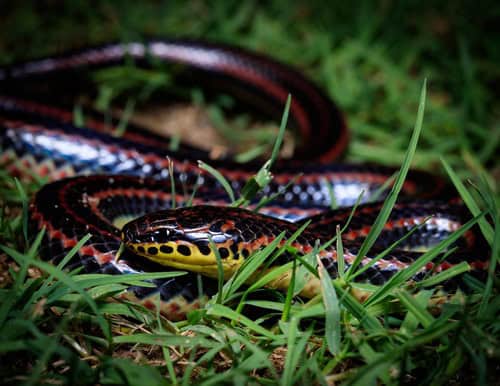
Stumbling across a timber rattlesnake isn’t that difficult, if you’re wandering through a leafy forest filled with fallen logs. Finding a common garter snake in a pond is nothing noteworthy simply because they’re so abundant. But there’s one US snake that would earn you at least a bronze herper badge for finding, and that’s the rainbow snake (Farancia erytrogramma), a non-venomous species measuring 50-150cm.
Rainbow snakes pose no threat to humans and inhabit 9 states in the eastern US. Their western extent is eastern Louisiana, and to the north they just reach southern Maryland. Their heartlands are the Carolinas, Georgia and Alabama, and they’re plentiful in northern Florida and the panhandle, but fizzle out in the centre before reaching Orlando.
Rainbow snakes are a semi-aquatic species which typically appear in scenic creeks with shady overhanging branches, clear flowing streams and freshwater marshes. They avoid coastal areas, but like sheltered inland water bodies where they easily vanish from herons, hawks and indeed humans. Rainbow snakes were named for their spectacular colours, and are 1 of just 2 members of the Farancia genus. Their closest relative is the slightly longer mud snake (Farancia abacura) which tends to appear in gloomier, murkier swamps, often alongside alligators.
| 2 | ID signs to remember |
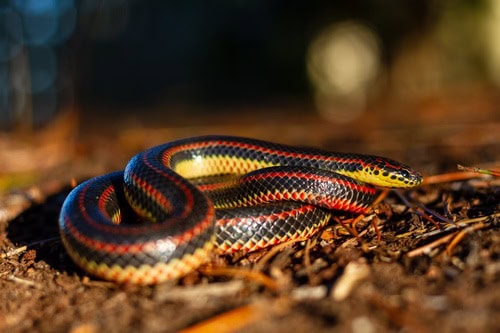
Despite their flashy colours, rainbow snakes can look surprisingly dull from a distance (see this video), so you might have to get up close before making a conclusive ID. Red, yellow and dark bluish-black are their main colours, with a slight iridescent sheen.
Blue-black is the underlying colour when viewed from above. Next, we have three red stripes: one down the spine, and one on each flank. The yellow only begins at their lower sides, also covering their mouth and chin.
As for the less obvious features, females are significantly longer than males, reaching an all-time record of 173.3cm, versus just 107.4cm for males. Their scales are smooth to touch rather than jagged and keeled. Their pupils are round rather than vertical, despite being mainly nocturnal. Rainbow snakes also have small eyes and even a small tongue, while their body is thick and cylindrical.
Lucky, there’s no snake that quite resembles them. Their mud snake relative lacks any yellow, being purely black and red. The red is more cleanly separated with mud snakes, starting only at the belly.
| 3 | Addicted to eels |
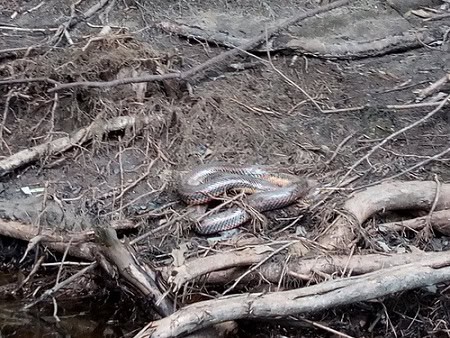
Rainbow snakes are similar to their mud snake cousin in many ways, but their diet is a sharp divergence. Mud snakes feast exclusively on amphibians, especially greater sirens and three-toed amphiumas. Rainbow snakes, meanwhile, are believed to eat eels exclusively. They have a very narrow diet, specifically focussing on the American eel (Anguilla rostrata).
This has led locals to dub them the eel moccasin. Farancia erytrogramma is too impatient to wait and swallows its prey alive, usually headfirst, without bothering to constrict. After completion, they waddle to the shores of their creeks, or into a cypress root bed, or shoreline shrubs, and begin the digestion process in comfort.
Captive juveniles happily swallow up tadpoles, adult salamanders and salamander larvae. As they mature, juveniles grow more and more reluctant to swallow these tiny black tadpoles, even if artificially scented with Anguilla eels. Once adulthood is reached, they refuse to eat any tadpoles, and their eel cravings take over their mind completely.
| 4 | No weapons at all |
While rainbow snakes have teeth, they’re only used to grip eels’ slippery bodies, and biting a human that picks them up is virtually unheard of, just like a mud snake. All rainbow snakes do is thrash from side to side, or give you a mild forceful poke with their mildly pointy tail.
This tail decreases in pointiness from youth to adulthood, making adults largely defenceless, though their extreme ability to disappear into muddy shoreline holes is a defence in itself. The fact that rainbow snakes are immensely challenging to find even for seasoned herpetologists shows that they’re doing everything nature intended them to. Like the mud snake, their pointed tail may give them extra agility in the unstable shoreline muds, poking their way forward step by step.
Among non-venomous US snakes, the Nerodia watersnakes rank near the top for willingness to unleash savage bites. The Farancia genus is down at the very bottom, well below garter snakes or ratsnakes. Their pointy tail has also led to a folklore belief that rainbow snakes can sting.
| 5 | The mysterious southern form |
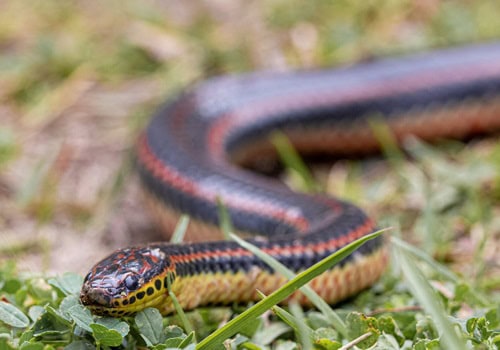
Rainbow snakes are fairly widespread, but hidden within this species lies one of the world’s greatest serpent mysteries. There’s an incredibly rare subspecies called the southern rainbow snake, found in Florida, which is considered to be the least studied snake in the USA, possibly extinct, but possibly still alive.
Only three specimens were ever collected, from 1949 to 1952. Two were lost, and the other preserved in a museum collection. Its known territory was tiny, consisting of just Fisheating creek in Glades County, which flows into the west side of Lake Okeechobee, the largest freshwater lake in Florida (easily visible from space).
It was separated from the main northern range by hundreds of miles – the entirety of Disney World, Orlando and Universal Studios lay between. No new sightings have occurred for 72 years, and some have given up hope, blaming pollution and the destruction of their eel prey base. But it’s easily possible that it exists under people’s noses, given how rarely it was detected in the first place.
The colours were the same, but in different proportions. The southern form has a blacker appearance than the northern, with blacker ventral (belly) scales pushing the red back, and a red lateral stripe with additional black encroaching. The southern rainbow snake was dubbed Farancia erytrogramma seminola after the native Seminole tribe which once lived on Lake Okeechobee’s shores. This is the only additional rainbow snake subspecies, as those everywhere else, from Louisiana to North Carolina, are simply F. erytrogramma erytrogramma. If it is extinct, then there’s just one subspecies.
| 6 | Are they still out there? |
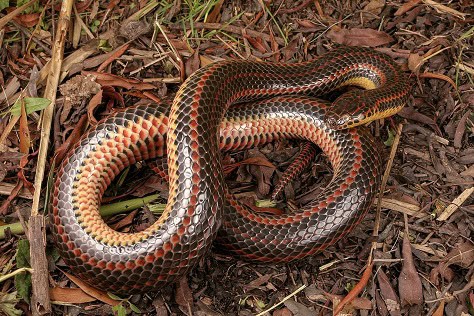
As of 2024, the southern rainbow snake still hasn’t been rediscovered. It was declared extinct in 2011 by the U.S. Fish and Wildlife Service, but the Center for Biological Diversity believed this to be premature. In November 2011, they offered a $500 reward for information leading to its rediscovery, in cooperation with the Center for Snake Conservation. Facts they pointed out were…
-The relatively pristine condition of Fisheating creek, where the original discovery happened in 1949.
-The southern rainbow snake’s nocturnal nature, making it hard to spot, particularly combined with its aquatic habitat.
-A spate of unconfirmed sightings in the late 1980s. They also mentioned sightings of snakes eating eels near Palmdale.
The duo believed that far few official surveys had been conducted to declare the subspecies extinct. As of 2024, many maps still have a small dark patch in central southern Florida, treating it as alive.
Are you an amateur herpetologist in Florida who’s bored of finding cottonmouths? Do you want a real quest to embark on, to secure your slice of glory? Then finding the elusive southern rainbow snake may be your opportunity.
| 7 | Stashes its eggs in mud |
Like mud snakes, rainbow snakes are a rare colubrid species to guard their eggs after they’ve been laid. They don’t care for their young post hatching, but they’ll dutifully stand watch for the typical 60-80 days they take to hatch.
Numbers are high at 10-52, though not matching the mud snake’s record of 119. Their scenic creeks and rivers are a world of opportunity for keeping their offspring safe. A mother rainbow snake’s strategy is to bury her stash 10-45cm deep in soft soils. They don’t require the excuse of eggs either, as adults bury themselves simply for shelter. Rainbow snakes have been found 3 metres deep in dry sand.
The eggs hatch in early autumn, and for the initial months of their life, rainbow snakes stay close to their secure muddy hatching hole, sheltering from predators. When winter turns to spring, they enter the adult world of rivers and creeks. The average newborn measures 19.7cm-28cm.
| 8 | Interactions with fellow snakes |
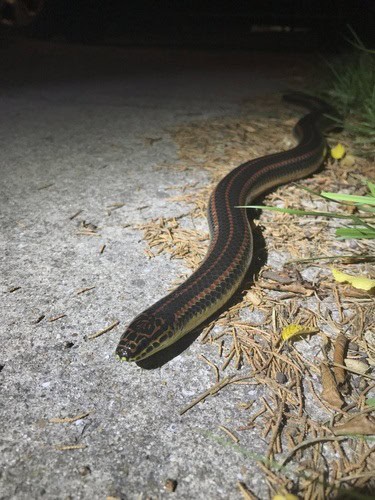
Being a subtle, elusive snake which loves to vanish into a creek bed the moment humans arrive, data is scarce for Farancia erytrogramma. One of its few confirmed nemeses is the cottonmouth, as witnessed in Stone County, Mississippi in April 2013.
In a roadside ditch, the cottonmouth was spotted with a rainbow snake one quarter down its throat, tail first. The cottonmouth noticed the scientists, regurgitated the rainbow snake, and fled upstream. The dead rainbow snake’s head was covered with maggots, showing that it was already dead when the cottonmouth began its meal. It measured 104.9cm, showing that Farancia erytrogramma isn’t safe even in adulthood.
Another confirmed snake predator is the eastern indigo snake, while rainbow snakes have never been recorded eating snakes themselves. Then there’s the red-shouldered hawk, seen clutching a rainbow snake in a marsh of Georgia’s Savannah river.
All this is extra motivation to stay hidden. There’s likely dozens of predators we haven’t observed. Rainbow snakes are elusive enough that in 2020, one was rediscovered in Florida’s Ocala National Forest for the first time in 51 years. This protected forest lies in Marion County, 47 miles north of Orlando, at the extreme southern end of the territory (excluding the mysterious southern subspecies).
| 9 | Ventures to land after rainfall |
Despite clinging to water, rainbow snakes can activate when the heaven opens, becoming much more adventurous, with a corridor opening via rainfall. The opposite can also happen: their scenic creeks can dry up, spurring them to travel overland. At certain locations, they also hibernate on land, and it’s theorised that this is more likely further north, where streams cool to dangerous levels for reptiles during winter.
One rainbow snake was found in a suburban neighbourhood in Myrtle Beach, South Carolina, unearthed below some leafy mulch. This was 20 metres from a small marsh. Rainbow snakes can be common in fields, such as dry sandy fields adjacent to marshes. At one spot in Virginia, 20 rainbow snakes were unearthed in a single day by ploughing a 10 acre field.
One study tested members of both Farancia species, including data from only those found on land, from the Carolina Herp Atlas. 6 rainbow snakes averaged at 44 metres from the nearest wetland boundary, with a range of 0–117 m. 17 mud snakes averaged at 62 meters away, with a range of 0–264 m.
| 10 | Hides below floating vegetation |
Eagle eyed fishermen can sometimes spot Farancia erytrogramma foraging on the beds of shallow streams, searching patiently for eel prey. Initially, they swallow their eels rapidly, before a slowdown in the latter stages. Consequently, rainbow snakes often sit on muddy shorelines with eel tail tips hanging out of their mouths.
Rainbow snakes are doubly hard to find because of their liking for floating vegetation. They typically lurk below fallen shoreline trees or mats of Spanish moss, and when hunting, it’s creekbeds and riverbeds they prowl, not the surface. They rarely appear above hard rocky streambeds, as they require muck and softness for their eel prey to dig tunnels in, and for their own tunnels.
In warmer climes like northern Florida, rainbow snakes skip hibernation completely. This species has been recorded as active in every month of the year. The furthest a rainbow snake has ever been found from the nearest water source was 2000 metres.
